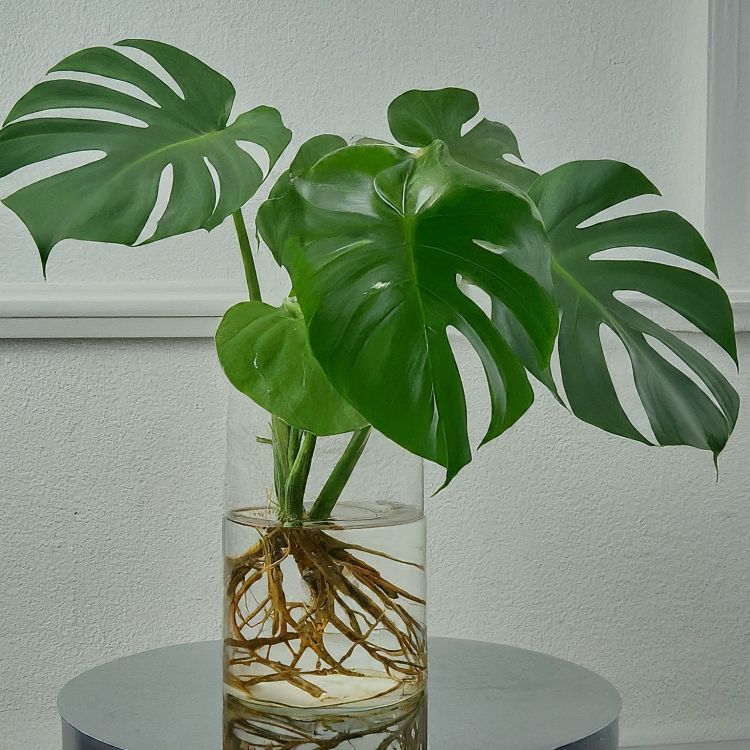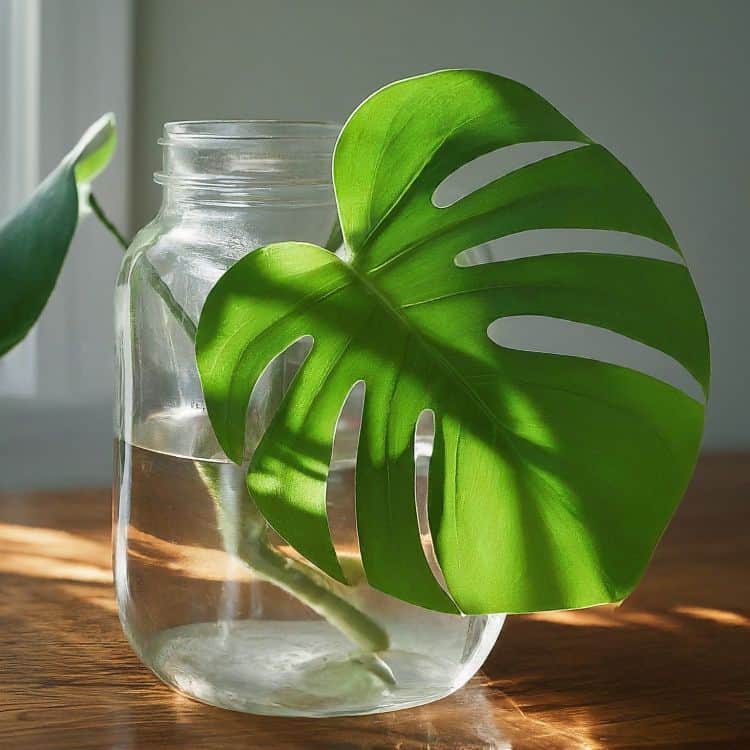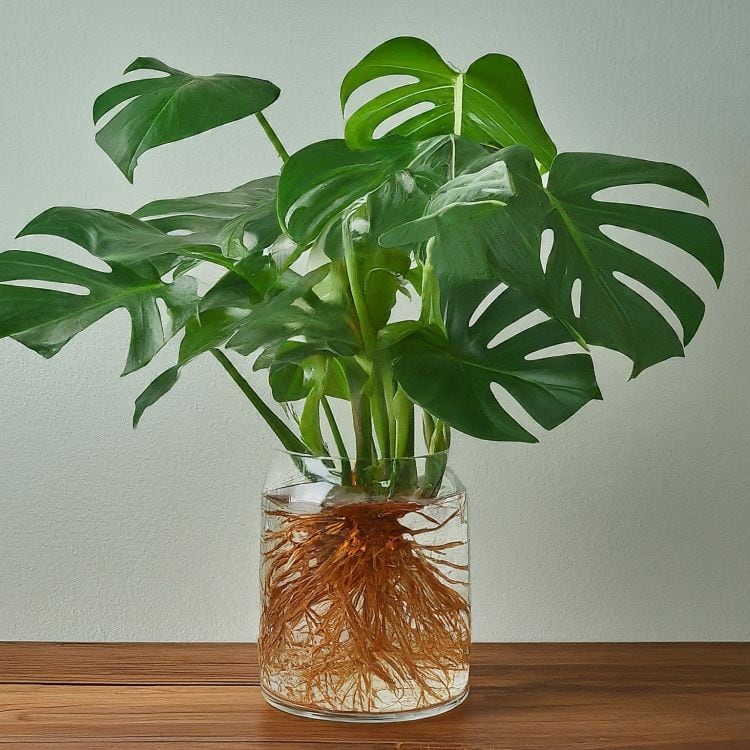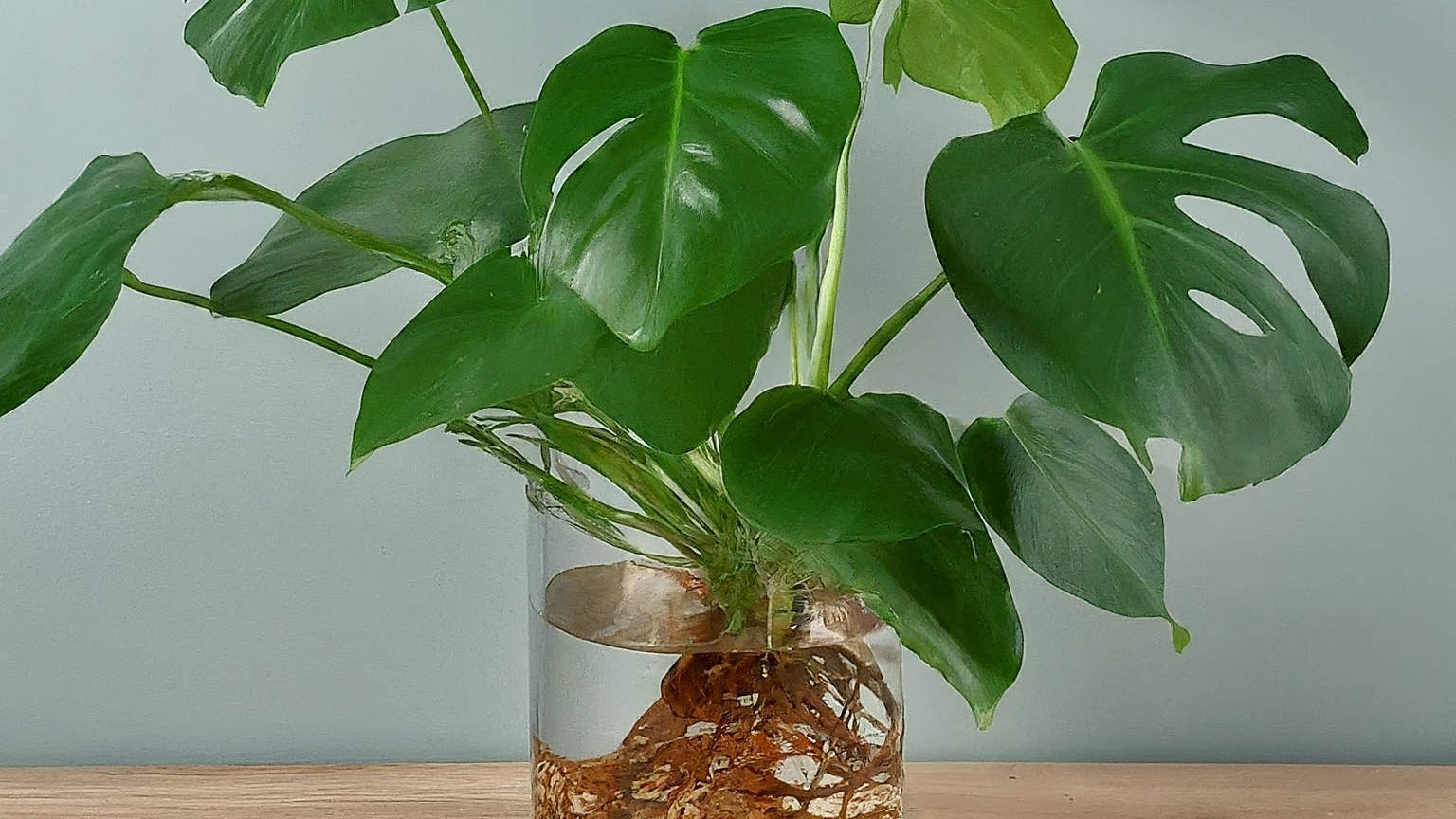Last updated on March 3rd, 2024 at 07:58 am
If you love the idea of having a Monstera plant but don’t have much space or time, try the Mini Monstera! It looks just like the big one but is smaller and easier to care for. Ideal for small living spaces, the Mini Monstera grows in bright and indirect light and needs minimal care, making it an excellent choice for new and seasoned plant enthusiasts alike.
Moreover, if you’re intrigued by aquatic environments, you can even experiment with growing your Mini Monstera in water. These plants are known for their adaptability to different conditions. So, the Mini Monstera may be the perfect solution if you’re yearning to bring a touch of tropical paradise into your home but need more space or time.
Contents
Why Grow Monstera in Water??

Growing a Monstera in water can offer several advantages, making it a compelling option for indoor gardeners. Below are the reasons you might consider trying this method, each explained in detail.
Low Maintenance
Water propagation offers a low-maintenance alternative to traditional soil-based methods. Unlike caring for plants in soil, water propagation eliminates the need for regular soil checks, watering schedules, and soil amendments. With this method, you can simply place your Monstera cuttings in water and let them thrive with minimal intervention. This makes water propagation particularly appealing for busy individuals or those new to plant care, as it reduces the time and effort required to maintain healthy growth.
Enhanced Visual Appeal
When cultivating Monstera in water, you’re not just nurturing green foliage; you’re cultivating captivating works of living art. These plants have the remarkable ability to develop stunning root systems when grown in water, enhancing the visual allure of any space they inhabit. Placed in transparent containers, the intricate and sprawling root structures become a focal point, creating an eye-catching display that invites admiration and curiosity.
Whether displayed on a windowsill, countertop or as a centerpiece, water-grown Monstera plants transform ordinary surroundings into vibrant and captivating environments, infusing your living space with natural beauty and charm.
By selecting to grow Monstera in water, you’re not just avoiding soil – you’re sidestepping many potential problems. Soil-borne pests like pesky fungus gnats and the dreaded root rot become a thing of the past when you choose water propagation. Without soil to harbor these pests and diseases, your Monstera enjoys a clean and hygienic growing environment, free from the stress and health issues they can cause.
Easy Monitoring of Root Health
Growing Monstera in water makes keeping an eye on its roots super easy. The clear containers let you see right through to the roots, so you can check their health and growth effortlessly. If there’s any sign of trouble, like root rot or not enough nutrients, you’ll spot it quickly and can fix it right away.
How to Grow Monstera in Water

Growing Monstera in water is a simple and rewarding process that anyone can do. Here’s a detailed guide to help you get started:
Select Healthy Cuttings
Choose a healthy Monstera cutting with at least one leaf node. Look for cuttings that are free from any signs of damage or disease. Aerial roots on the cutting can help it establish more quickly in water.
Prepare a Clean Container
Use a clean glass or plastic container for water propagation. It’s essential to use a container that has been thoroughly cleaned to prevent any contamination that could harm the cutting.
Add Water for Cuttings
Fill the glass container with room-temperature water. Ensure there’s enough water to submerge the bottom portion of the cutting while leaving the leaf node exposed above the water surface. Distilled or filtered water is preferred to minimize the risk of mineral buildup.
Place the Cutting
Carefully insert the Monstera cutting into the water. Position the cutting in such a way that the leaf node is submerged in the water, while the leaves should be above the surface of the water. Make sure the cutting is stable and doesn’t topple over.
Light Requirments
Place the water container in a place with bright but indirect light. Try to avoid placing it in a location that receives direct sunlight, as this can lead to overheating of the water and promote algae growth, which can be harmful to the cutting.
Monitor and Maintain
Monitor the water level in the container regularly and top up with fresh water to ensure the leaf node remains submerged. Keep an eye on the condition of the cutting and remove any yellowing or decaying leaves promptly.
Wait for Root Growth
Be patient and allow time for the Monstera cutting to develop roots. Root development typically takes several weeks to months, depending on various factors such as temperature, humidity, and the health of the cutting. During this time, avoid disturbing the cutting unnecessarily.
Transfer to Soil (Optional)
Once the cutting has developed a healthy root system, you can choose to transplant it into a pot with well-draining soil. Gently remove the cutting from the water and plant it in the soil, ensuring the roots are covered and the plant is stable. Water the newly planted Monstera thoroughly and continue to provide appropriate care as it adjusts to its new environment.
How to Care Monstera in Water?

Caring for Monstera in water is relatively simple and requires attention to a few key factors to ensure optimal growth and health. Here’s a guide on how to care for your Monstera plant in water:
Water Level
Keep the water level consistent to ensure that the leaf node of the Monstera cutting remains submerged. Check the water level regularly and top up with fresh water as needed to maintain the desired level.
Water Quality
Use filtered or distilled water to fill the container for Monstera propagation. Tap water may contain chlorine or other chemicals that could harm the plant or promote algae growth in the water.
Light Exposure
Place the container in a location with bright, indirect light. Avoid direct sunlight, as it can cause the water to heat up and promote algae growth, which can be detrimental to the Monstera cutting.
Temperature and Humidity
Maintain moderate room temperature and humidity levels around the Monstera cutting. Avoid placing it near drafts or heating vents, as extreme temperature fluctuations can stress the plant.
Root Health
Monitor the development of roots regularly. Healthy roots should appear white or light-colored and firm to the touch. Trim any roots that appear mushy or discolored, as they may indicate rot or other issues.
Fertilizer
Consider adding a small amount of liquid fertilizer to the water occasionally to provide essential nutrients for the Monstera cutting. Use a balanced fertilizer diluted to half strength to avoid over-fertilization.
Pruning
Remove any yellowing or decaying leaves promptly to maintain the overall health and appearance of the Monstera plant. Pruning encourages new growth and prevents the spread of diseases.
Container Maintenance
Regularly clean the container and change the water to prevent the buildup of algae, bacteria, or other contaminants. Wash the container with mild soap and water, and rinse thoroughly before refilling with fresh water.
Water Qualities for Propagation of Monstera in Water
Ensuring the right water qualities is crucial for successfully propagating Monstera in water. To promote healthy growth and prevent issues, it’s essential to use chlorine-free water, preferably filtered or dechlorinated, to protect delicate roots. Maintaining a slightly acidic to neutral pH level, typically between 6.0 to 7.0, helps create an ideal environment for root development.
Using distilled or filtered water minimizes mineral content, reducing the risk of mineral buildup on roots. Contaminant-free water, free from heavy metals and chemicals, safeguards the plant from harm. Additionally, maintaining water at room temperature and ensuring adequate oxygenation support optimal growth conditions for Monstera propagation.
FAQS
Can I grow Monstera in water indefinitely?
While Monstera plants can be propagated and grown in water indefinitely, they may benefit from occasional transplantation into the soil to replenish nutrients and provide additional stability.
How often should I change the water for Monstera propagation?
It’s recommended to change the water for Monstera propagation every one to two weeks to prevent the buildup of algae, bacteria, and other contaminants.
Can I propagate Monstera from a single leaf cutting in water?
While Monstera plants can be propagated from single leaf cuttings, they may require longer timeframes for root development compared to stem cuttings with leaf nodes.
Is it normal for Monstera roots to change color in water?
Monstera roots grown in water may naturally develop a tinted appearance over time due to exposure to water and minerals. However, if the roots exhibit signs of rot or discoloration, it’s essential to take corrective action to maintain plant health.
Can I use tap water for Monstera propagation?
Tap water containing chlorine or other chemicals may be harmful to Monstera plants. Using filtered or distilled water is recommended to minimize the risk of damage and ensure optimal growth conditions.
Bringing Monstera into Your Home
Incorporating Monstera plants into your living space, whether as Mini Monstera varieties or through water propagation, offers a delightful way to introduce tropical beauty and greenery into your home.
With their striking foliage and adaptability to various growing conditions, Monstera plants can thrive in small spaces, making them ideal companions for apartment dwellers and urban gardeners alike.
By exploring water propagation methods, you not only simplify plant care but also open up new possibilities for creative displays and observation of root development. Whether you’re a novice gardener or a seasoned plant enthusiast, the Mini Monstera and water-grown Monstera offer accessible and rewarding avenues for adding natural charm to your home environment.

